Learning how to play guitar solo scales is a rite of passage for every budding guitarist, so let’s get you acquainted with the most important scales first.
Over 250,000 guitar-learners get our world-class guitar tips & tutorials sent straight to their inbox: Click here to join them
In this free lesson you will learn…
- Five guitar solo scales that can improve your playing
- Why backing tracks are so important
- Tips for making your notes ring out clearly
- The #1 reason why ear training is so important
- Links to some awesome backing tracks for practice
Level-Up Your Lead Chops With Guitar Solo Scales
It’s no secret that there are hundreds of ways to combine the 12 notes in western music.
Learning to combine these notes together in creative ways is a cornerstone of guitar playing, but it can be pretty overwhelming at the beginning.
If you’ve already learned a generous amount of chords, you’re probably wondering how you can go about soloing over them in a musical way.
Well, you’re in luck. Guitar solo scales are easy to learn and easy to play. They’re also easy to teach, which is great for us.
Let’s look at what we’re deep-diving on today below.

Guitar solo scales come in a bunch of different varieties that allow us to imply different notes over specific chords.
Whether you’re an absolute beginner or a budding intermediate guitarist, you’re going to need to learn to play guitar solo scales at some point.
Why not make it happen now?
Let’s dive in and answer an important question first.

Why Should I Bother Learning Scales?
Music is like a puzzle – we’ve got to have the right pieces to put it together and make it all fit.
When we pair the right scales with the right chords, we create a beautiful array of musical tones that fit perfectly together.
Guitar solo scales give us a huge level of freedom of expression, and that’s exactly what we want to embrace when we learn them.
It doesn’t just help your fingers and your expression, but it helps something else also.

Download our lead guitar cheat-sheet to make things easier
It's hard to understand which scales work with which keys.
So we created a cheat-sheet! A key and scale-finder that you can use again and again.

Get your personalised guitar-learning plan 🎸
Get a custom guitar-learning plan here: Click here for GuitarMetrics™
World-Class Guitar Courses 🌎
Learn from the world's best guitar educators: Click here for our guitar courses
It’s Not Just About Your Fingers – It’s About Your Ears, Too
The big advantage in this lesson is learning the scale shapes so that you can play them, but the bigger advantage is being able to hear them.
Ear training is extremely important for every guitarist. It’s not a thing you have to commit to for several hours each day, but it is something you should pay close attention to.
Each chord and scale in music has its own distinct tone that makes it unique from every other.
Once we learn how these sound, it becomes a lot easier to piece things together in a musical manner.

Pro Tip: As you go through this lesson and learn the various guitar solo scales, we strongly encourage you to try to hum or sing the notes that you play.
At least one of you just laughed, but we’re serious – this is the best way to get the notes you play inside your head quicker and more effectively.
When we sing or hum along to what we play, our ears begin to actively recognize those notes more easily.
Although many of us don’t have perfect pitch, you can use this technique to develop your relative pitch which will help you pick out notes, chords and even guitar solo scales more easily.
Now, let’s get down to the first scale on this list.

Guitar Solo Scales I – The Minor Pentatonic Scale
This is typically the first scale that most beginner guitarists encounter, so it makes sense to put it right up at the top of our list.
Why is this the first scale most people learn? Because it’s extremely straightforward to play, and it works in most musical contexts quite easily.
Where some guitar solo scales fit better over certain chords, the minor pentatonic scale works just about anywhere.
Whether you’re playing a pop tune, a blues song or even a jazz odyssey, the minor pentatonic scale is one of the best guitar solo scales you can learn.
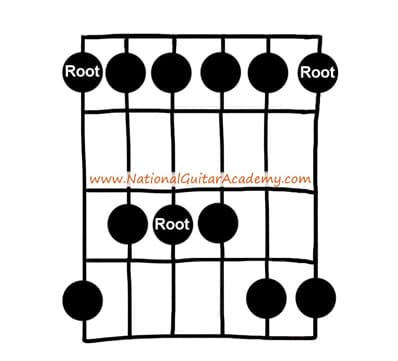
The term “pentatonic” means “five tones,” meaning that there are five notes that make up this scale.
Assign one finger to each fret, and work in four-fret boxes in order to master these scales effectively.
We’re going to learn this scale in the key of A, so start at the 5th fret to play the A minor pentatonic scale correctly.
Assign your fingers to the following frets:
Index: 5th
Middle: 6th
Ring: 7th
Pinky: 8th
The notes of our A minor pentatonic scale in order are:
A – C – D – E – G
It’s good practice to make sure each of the notes rings out clearly to get used to the amount of pressure needed.
Have a look at the first of our guitar solo scales in the diagram below:

Guitar Solo Scales II – The Major Pentatonic Scale
For every minor scale, there is a major counterpart to learn.
The major pentatonic scale follows the same structure as its minor cousin – five notes, but in a different order.
It’s important to pay attention to the order of the notes in each of these guitar solo scales, as the distances between them is what makes the scale sound a specific way.
For example, the major pentatonic scale has a happier sound to it, where the minor scale has a more neutral (or sad, depending) sound. These scales sound entirely different because their structure is different.
Once we start applying chords to our guitar solo scales, you’ll start to notice the differences even more.
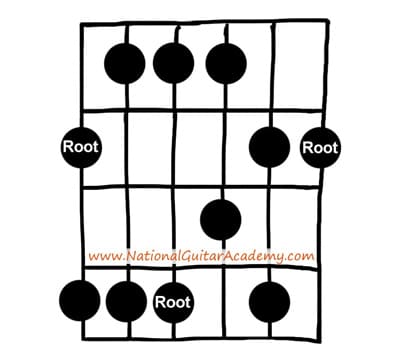
Here’s a cool thing:
Did you know that a major scale and a minor scale can share the same notes?
It’s true – and we’re going to show you how. When a minor scale shares notes with a major scale, it is referred to as the relative minor of that major scale.
Let’s look at the C major pentatonic scale’s notes.
C – D – E – G – A
Notice how the notes are the same, just in a different order?
Now have a look at the scale shape diagram below, and say the notes out loud as you play them. Once you get to A, simply count from C again!

Guitar Solo Scales III – The Major Diatonic Scale
Now that we’ve discussed pentatonic scales, it’s time to add two more notes into the mix.
The term “diatonic” means “seven tone,” meaning that we have seven notes that make up this scale.
If we were to take our C major pentatonic scale above and convert it to a diatonic scale, the note order would look like this:
C – D – E – F – G – A – B
or:
Do – Re – Mi – Fa – So – La – Ti
See how the notes are in complete order now from C to B? This is because the C major scale does not use any sharp (or flat) notes.
Using the same principle of one finger per fret in a four fret box, let’s now take a look at the scale diagram below:
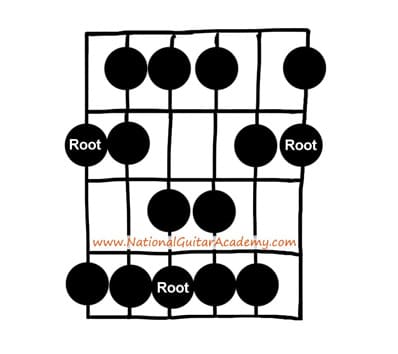
Pro Tip: You’ll want to use alternate picking in order to get the best economy of motion out of these scales.
The guitar solo scales on this list also serve as great exercises for getting your fingers acquainted with unfamiliar positions, so take all the time you want to hash out these scales in full.
Start this scale with your middle finger on the root note in order to allow your index finger to take the fret behind it without moving your hand’s position at all.
The best way to practice these scales is both ascending and descending, so play them both ways!

Guitar Solo Scales IV – The Minor Diatonic Scale
Now, it’s onto the moodiest scale we’ve encountered yet.
Like the major scale above, the minor scale also contains seven notes. The order is similar to what we saw in the minor pentatonic scale, but with two additional notes.
Let’s check it out in the key of A once again:
A – B – C – D – E – F – G
or:
La – Ti – Do – Re – Mi – Fa – So (compared to the major scale above)
Once again, take note of the notes that have been added (B and F).
Guitar solo scales require practice to get them sounding right, so take some time with the A minor diatonic scale shape below and really hash it out.
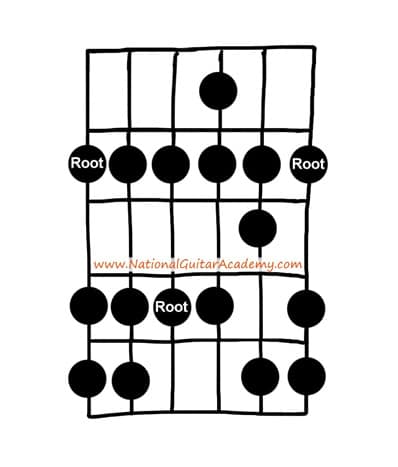
Each of these guitar solo scales are composed of two different brands of distance between notes:
Tones (or “whole steps”) and semitones (or “half-steps”).
A tone is made with a two-fret distance between two notes (for example, C to D on the 3rd and 5th fret of the A string).
A semitone is made with a one-fret distance (for example, C to C# on the 3rd and 4th frets of the same string).
The combination of tones and semitones is what gives each scale its specific flavour, so pay close attention to which notes are next to each other and which are further away.
Have a run through the tab below, then let’s move onto one of two more unorthodox guitar solo scales on our list.

Learn 12 EASY beginner chords with our popular guide

✅ Stop struggling. Start making music.
✅ Learn beginner-friendly versions of every chord.
This is our most popular guide and it will improve your chord ability quickly! 😎
Get your own personalised guitar-learning plan 🎸
Get a custom guitar-learning plan here: Click here for GuitarMetrics™
World-Class Guitar Courses 🌎
Learn from the world's best guitar educators: Click here for our guitar courses
Guitar Solo Scales V – The Minor Blues Scale
So, what if we took the minor pentatonic scale that we learned first and added just one note to it?
Well if you placed that note in the right spot, you’d have the minor blues scale.
For reference, this scale also goes by the “minor pentatonic blues” or “pentatonic blues” scale as well.
Let’s first look at the difference between the A minor pentatonic scale and the A minor blues scale below
A Minor Pentatonic Scale:
A – C – D – E – G
A Minor Blues Scale:
A – C – D – D# – E – G
Have a look at the scale diagram below, then let’s discuss more about how these guitar solo scales work differently than the others.
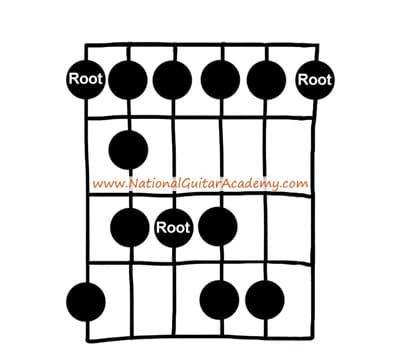
The minor blues scale has one key component that sets it apart, and it’s the addition of the “blue note.” This note creates a path where we can “walk” up or down between the D and E notes.
This is especially handy if you want to create an extremely blues-y sound during a solo over any set of chords.
Try this: Go check out this blues backing track in A minor that you can use to practice soloing over.
Play up and down the scale, and listen for how each note plays with the chord progression.
Techniques like hammer-ons, pull-offs and slides are all welcome here, be as fearless as you like!
We’ve got a tab for you below, so check it out before we start building a routine around these guitar solo scales.

Building An Effective Practice Routine For Guitar Solo Scales
It’s one thing to know how to play these notes in sequence, but we need to figure out how to make them sound musical.
Scales are a foundational device for every musician. The more you know about your guitar solo scales, the easier it is not only to solo but to write riffs as well.
We’ve got a few pointers and resources for you below that will help you work on your guitar scale chops:
- Practice slowly and with a metronome whenever possible. You want to make sure that every note has the chance to ring out completely. If you don’t have a metronome, click here to get one free online.

- Learn more about the fretboard in order to practice these guitar solo scales in different keys effectively. Check out the fretboard diagram above for reference.
- Make use of backing tracks to help your ears get familiarized with the sound of the scales against different chord progressions. Check out a few of our favourites below:
- Blues in A minor
- Ballad in C major
- Pop in A minor
- Rock in A minor
Guitar solo scales give us a world of expression within our fingertips when we know how to use them. Understanding how each note plays against different chords is extremely important, so make sure to practice well and play attentively.
The key with all of this is practice and time, so make the commitment and your guitar will thank you for it.
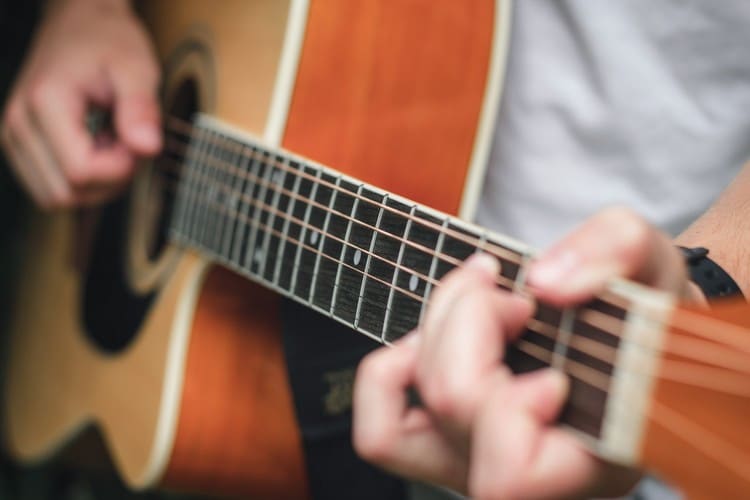
One More Pro Tip Before You Go…
Once you’ve learned these guitar solo scales and start to realize how they function, it’s never a bad idea to try and play a short guitar solo by one of your favourite artists.
The more you practice your scales, the easier it will be for you to recognize what scales they were playing when they recorded the song.
Scales can help us to understand the universal language of music, and they’re always worth the time it takes to play and comprehend them.
When you feel that you’ve mastered these guitar solo scales, you’ll be in a great position to venture out in a multitude of different musical directions.
Remember: A good foundation leads to great progress!
Recommended Resources
If you enjoyed this lesson on how to play the most fundamental guitar solo scales, you’re going to love the other lessons we’ve got laid out for you below:
- Guitar Scales Chart
- Guitar Scales Tabs
- Guitar Scale Exercises
- Notes on a Guitar – Unlocking The Fretboard
- What Is The Root Note Of A Chord
What Type of Guitarist Are You?
Take our 60-second quiz & get your results: Take The Quiz
Join the world's best online guitar school 🌎
- Get your own personalised guitar learning plan (customised just for YOU).
- World-class online guitar courses. Learn at your own pace.
- Community Campus & Learning Forum - A friendly community! Connect with our team & students. 😊
- Beginner Song library with chordsheets, tabs and tips. (Songs suitable for all levels!)
- Regular live streams, seminars and Q&A sessions - Learn from world-class guitar educators. Get all your questions answered!
Click here to learn more about National Guitar Academy membership 
Cool Guitar T-shirts 😎
Look cooler! Check out our merch: Click here to see our merch store
Want free guitar tips and video lessons delivered to your inbox?
Join over 250,000 other guitar learners and subscribe to our guitar-tips-by-email service. (It's free.)
We'll send you a series of lessons that will move you to the next level of your guitar journey.
Learn how everything fits together quickly, easily and effectively. We share ninja tips (for instant fun!) but also timeless fundamentals that will deepen your understanding.

Popular Lessons
How To Learn Guitar: An 11-Step Programme For Beginners
How To Choose The Perfect Beginner Guitar
More Cool Guitar Stuff
Learn about National Guitar Academy: About Us
Visit our YouTube channel for fun guitar videos.
Join us on Facebook for daily guitar tips.
Listen to our Learn Guitar Podcast for rapid guitar progress.
Check out our free chord lessons.
Get our best guitar tips & videos
Where should we send it?
Where should we send it?
Get our best guitar tips & videos


